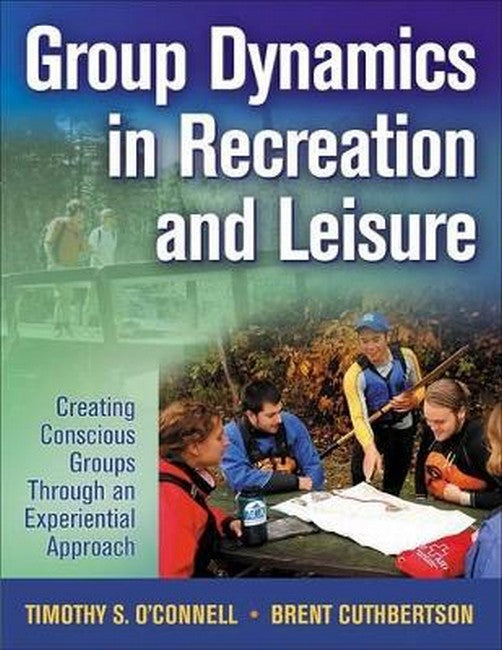Timothy S. O'Connell, PhD, is an associate professor in the department of recreation and leisure studies at Brock University in St. Catharines, Ontario, Canada, where he teaches outdoor recreation and group dynamics courses. With over 20 years of experience as a wilderness guide, O'Connell has developed firsthand experience of the workings and outcomes of group dynamics. As an instructor at the high school and college level, he has taught group dynamics for 15 years. O'Connell is currently conducting research on the social psychology of groups as well as developing a new outdoor recreation curriculum to include group dynamics courses. O'Connell is coeditor for the Journal of Experiential Education and a member of the Association for Experiential Education, the National Recreation and Parks Association, and the Council of Outdoor Educators of Ontario. O'Connell and his wife, Dr. Mary Breunig, reside in Ridgeville, Ontario. An avid outdoor recreationist, he has led over 100 wilderness trips, including integrated trips of people with and without disabilities, with Dr. Breunig, coauthor of Outdoor Leadership: Theory and Practice (Human Kinetics). In his free time, he enjoys rock climbing, sea kaying, and home brewing. Brent Cuthbertson, PhD, is an associate professor and director in the School of Outdoor Recreation, Parks, and Tourism at Lakehead University in Thunder Bay, Ontario, Canada, where he teaches courses in outdoor leadership and experiential education. Cuthbertson has over 25 years of experience as a wilderness adventure educator and guide. In both 2002 and 2004 he received the Lakehead University Merit Award for Excellence in Teaching. He is also the associate editor for the Journal of Experiential Education. Cuthbertson enjoys wilderness canoeing and sea kayaking, woodworking, and walking with his dogs. He resides in Thunder Bay, Ontario.
Request Academic Copy
Please copy the ISBN for submitting review copy form
Description
Part I: Understanding the Conscious Group Chapter 1: Introduction to Group Dynamics -Groups in Human History -Groups Defined -Classifications of Groups -Group Dynamics -Why Study Groups? -Summary -References Chapter 2: Group Formation and Development Theory -Why People Join Groups -What Makes Groups Attractive? -What Happens Next? -Group Development Theories -The Group-Individual Relationship -Summary -Questions for Discussion -Recommended Websites -References Chapter 3: The Conscious Group -Group Purpose -Personal Growth in Recreation Groups -Experiential Education -Experiential Education and Group Dynamics -Summary Part II: Developing the Conscious Group Chapter 4: Group Goals, Objectives, and Expectations -Defining Terms -Clarifying Goals, Objectives, and Expectations -Summary Chapter 5: Values, Ethics, and Morals -Definitions -Moral Development -Applying Moral Theory -Moral Reasoning Exercises -Summary Chapter 6: Decision Making and Problem Solving -Advantages of Group Decision Making -Disadvantages of Group Decision Making -A Six-Step Process for Making Decisions -Common Methods of Group Decision Making -The Leader and Decision Making -Summary -References Chapter 7: Power and Conflict -Power -The Operation of Power in Groups -Managing Conflict -Summary Chapter 8: Gender in Group Dynamics -Gender and Sex -Gender and Recreation Behavior -Generalizations About Gender-Specific Behaviors -Gender and Leadership -Conformity -Decision Making -Communication -Conflict Management -Power -Status -Task Solutions -Summary -References Chapter 9: Group Leadership -What Is Leadership? -Followership -Leadership Theory -Applying Leadership Theory -Summary -References Chapter 10: Environmental Impacts on Groups -Environmental Factors -Social Environment -Case Study -Summary -References Part III: Addressing Issues in the Conscious Group Chapter 11: Strengths, Weaknesses and Myths in Group Dynamics -Strengths of Groups -Weaknesses of Groups -When to Work Alone -Myths in Group Dynamics -Practical Techniques for Addressing Group Needs -Summary -References Chapter 12: Crowds and the Mob Mentality -Collectives -Behavior in Crowds -Strategies for Working With Collectives -Summary Chapter 13: Alternative Groups -Consensus-Based Groups -Participant-Centered Groups -Working With Alternative Recreation Groups -Summary Chapter 14: Diversity and Difference -Diversity and Difference -Types of Diversity -Benefits of Diverse Groups -Shortcomings of Diverse Groups -Working With Diverse Groups -Summary -References

